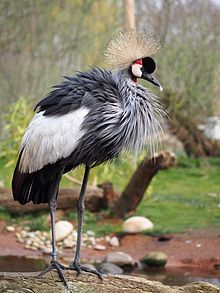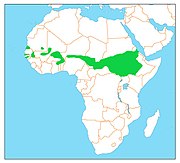Balearica
This article needs additional citations for verification. (September 2014) |
| Balearica | |
|---|---|

| |
| Grey crowned crane (Balearica regulorum) | |
| Scientific classification | |
| Domain: | Eukaryota |
| Kingdom: | Animalia |
| Phylum: | Chordata |
| Class: | Aves |
| Order: | Gruiformes |
| Family: | Gruidae |
| Subfamily: | Balearicinae |
| Genus: | Balearica Brisson, 1760 |
| Type species | |
| Ardea pavonina[1] Linnaeus, 1758
| |
| Species | |
|
See text | |
| Synonyms | |
| |
The bird genus Balearica (also called the crowned cranes or Balearic cranes) contains two extant species in the crane family Gruidae: the black crowned crane (B. pavonina) and the grey crowned crane (B. regulorum).[2]
The species today occur only in Africa, south of the Sahara Desert, and are the only cranes that can nest in trees. This habitat is one reason the relatively small Balearica cranes are believed to closely resemble the ancestral members of the Gruidae.
Like all cranes, they eat insects, reptiles, and small mammals.
Taxonomy
[edit]The genus Balearica was erected by the French zoologist Mathurin Jacques Brisson in 1760 with the black crowned crane (Balearica pavonina) as the type species.[3][4][5] The name is from the Latin Baliaricus for "of the Balearic Islands".[6]
The crane family (Gruidae) is divided into the subfamily Gruinae of typical cranes and the subfamily Balearicinae of crowned cranes.[7]
Extant species
[edit]| Common name | Scientific name and subspecies | Range | Size and ecology | IUCN status and estimated population |
|---|---|---|---|---|
| Black crowned crane | Balearica pavonina (Brisson, 1760) Two subspecies
|
Africa south of the Sahara
|
Size: Habitat: Diet: |
VU
|
| Grey crowned crane | Balearica regulorum (Bennett, 1834) Two subspecies
|
East of the Democratic Republic of the Congo and in Uganda, Angola south to South Africa
|
Size: Habitat: Diet: |
EN
|
Fossil record
[edit]Crowned cranes seem to have been more widespread prehistorically. Compared to the true cranes, genus Grus, which were always common in the Holarctic and adjacent regions, the present genus appears to have had a more Atlantic distribution, ranging into Europe and North America; it is not known from the fossil record of Asia and South America, as none have yet been discovered.
- Balearica rummeli (Early Miocene of Germany) – formerly Basityto
- Balearica excelsa (Early–Middle Miocene of France) – formerly Grus and Ornithocnemus
- Balearica exigua (Miocene of Nebraska)
References
[edit]- ^ "Gruidae". aviansystematics.org. The Trust for Avian Systematics. Retrieved 2023-07-27.
- ^ "ITIS Report: Balearica". Integrated Taxonomic Information System. Retrieved 29 July 2014.
- ^ Peters, James Lee, ed. (1934). Check-list of Birds of the World. Vol. 2. Cambridge, Massachusetts: Harvard University Press. p. 154.
- ^ Brisson, Mathurin Jacques (1760). Ornithologie, ou, Méthode contenant la division des oiseaux en ordres, sections, genres, especes & leurs variétés (in French and Latin). Vol. 1. Paris: Jean-Baptiste Bauche. p. 48.
- ^ Brisson, Mathurin Jacques (1760). Ornithologie, ou, Méthode contenant la division des oiseaux en ordres, sections, genres, especes & leurs variétés (in French and Latin). Vol. 5. Paris: Jean-Baptiste Bauche. p. 511.
- ^ Jobling, James A. (2010). The Helm Dictionary of Scientific Bird Names. London: Christopher Helm. p. 66. ISBN 978-1-4081-2501-4.
- ^ "The Cranes: Status Survey and Conservation Action Plan: Evolution and Classification". U.S. Geological Survey. 1 February 2013. Archived from the original on 20 March 2014. Retrieved 27 March 2014.


